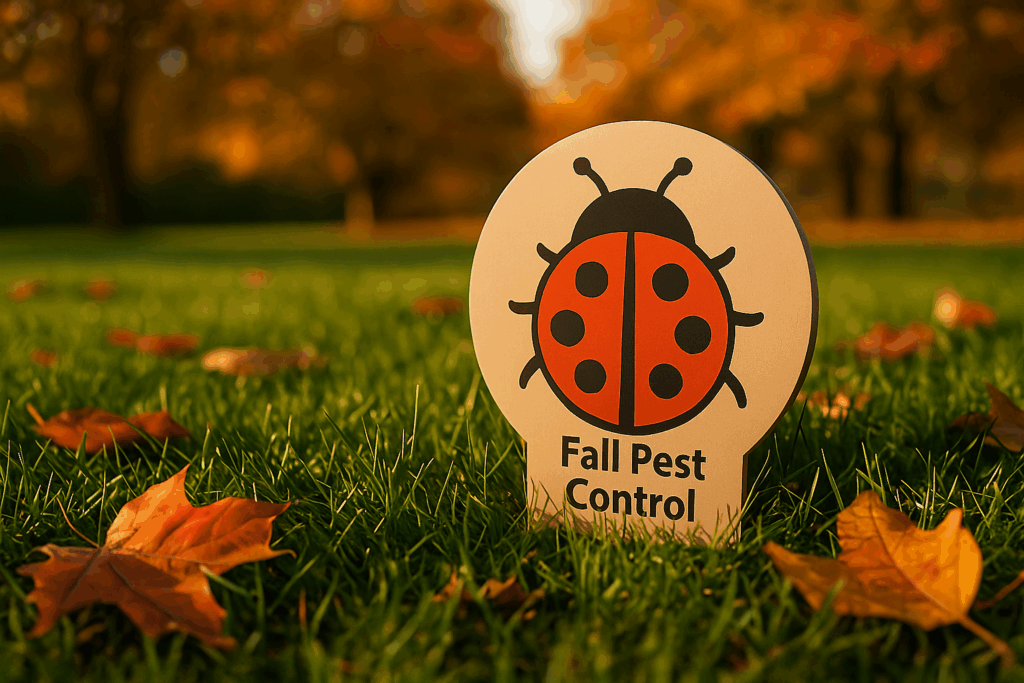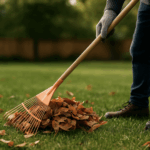Fall pest control for lawns becomes crucial as temperatures drop and pests seek shelter in your grass. Many homeowners notice increased pest activity during autumn, making it essential to understand effective prevention and treatment strategies. This comprehensive guide, backed by two decades of professional experience in Idaho’s unique climate conditions, addresses the most common questions about maintaining pest-free lawns throughout the fall season.
1. What Makes Fall Pest Control for Lawns So Important?
Fall pest control for lawns is vital in protecting your yard’s health before winter arrives. According to the University of Idaho Extension, insects like billbugs, grubs, and spiders become more active, seeking warm places to overwinter¹ as temperatures cool. Additionally, fall provides the perfect opportunity to address pest issues before they become severe problems in spring.
During autumn, pests often lay eggs in soil and grass, leading to significant damage when they hatch next season. Research from Colorado State University Extension shows that many lawn pests complete their life cycles in fall, making this the optimal time for intervention². Therefore, implementing effective fall pest control for lawns now prevents costly repairs later. Professional services like billbug control can identify and treat these issues before they escalate.
Expert Insight: “In our 20+ years serving Idaho homeowners, we’ve consistently observed that fall treatments reduce spring pest problems by up to 80%,” notes Lawn Master’s certified pest management team.
2. Which Pests Should I Watch for During Fall Lawn Care?
Several common pests become particularly problematic during the fall pest control for lawns season. The University of California IPM Program identifies billbugs as among the most destructive, as adult beetles feed on grass stems and lay eggs in the soil³. Grubs also pose significant threats, feeding on the grass roots throughout autumn and causing brown patches.
According to entomological research from Montana State University, spiders frequently move indoors during fall, but many species first establish themselves in lawn areas⁴. Furthermore, chinch bugs and armyworms remain active during cooler weather. Fall pest control for lawns should target these specific threats while preparing your yard for winter. Lawn Master’s comprehensive pest control services systematically address each concern.
Key Fall Pests to Monitor:
- Billbugs: Adult beetles are active September-October
- White Grubs: Peak feeding period in early fall
- Chinch Bugs: Continue to damage until first frost
- Armyworms: Late-season feeding before overwintering
- Various Spider Species: Seeking shelter opportunities
Professional experience: “Our Idaho service area sees particularly high billbug activity due to our specific grass types and climate patterns,” explains Lawn Master’s lead technician with 15+ years of field experience.
3. How Does Fall Pest Control for Lawns Work with Sustainable Methods?

Fall pest control for lawns focuses on sustainable methods that protect your family and the environment. The EPA’s Integrated Pest Management guidelines emphasize approaches including beneficial nematodes that naturally control grubs, companion planting that deters harmful insects, and organic treatments that break pest life cycles without harsh chemicals⁵.
Research published in the Journal of Economic Entomology demonstrates that biological control methods can be 70-90% as effective as chemical treatments when properly applied⁶. Fall pest control for lawns can be both practical and environmentally responsible.
Proven Sustainable Strategies:
- Beneficial nematodes for grub control (Steinernema species)
- Companion planting with pest-deterrent herbs
- Organic soil amendments to strengthen grass naturally
- Targeted application timing to minimize environmental impact
Certification Note: Lawn Master maintains certification in organic lawn care methods and follows all EPA guidelines for sustainable pest management.
4. What Are the Most Affordable Fall Pest Control Services for Lawns?
Affordable fall pest control for lawns doesn’t have to compromise on quality when you choose the right provider. Industry data from the Professional Lawn Care Association of America shows that seasonal packages provide 25-40% cost savings compared to individual treatments⁷.
Prevention remains the most cost-effective strategy for fall pest control for lawns. Research from Purdue University Extension demonstrates that proper lawn maintenance, including appropriate fertilization through lawn fertilization services, strengthens grass naturally, making it less susceptible to pest damage⁸. Additionally, combining pest control with other autumn services like sprinkler blowouts can reduce costs.
Cost-Effective Approaches:
- Seasonal treatment packages (typically 25-40% savings)
- Preventive maintenance programs
- Combined service bundles
- Early detection and treatment protocols
Local Market Insight: “Idaho homeowners typically save $150-300 annually by choosing comprehensive fall pest control for lawns versus reactive treatments,” based on Lawn Master’s 20+ years of pricing data.
5. How Do I Find the Best Fall Pest Control Companies for Lawns Near Me?
Finding the best fall pest control for lawns requires research and careful evaluation of credentials and local expertise. The Better Business Bureau recommends verifying licensing and insurance coverage and checking certified technician credentials⁹.
Essential Qualifications to Verify:
- State pesticide applicator licenses
- Liability and workers’ compensation insurance
- Certified technician training credentials
- Local climate and pest expertise
- Positive customer testimonials and references
Professional Standards: Lawn Master maintains Idaho Department of Agriculture pesticide applicator licenses, comprehensive insurance coverage, and ongoing technician education through the National Association of Landscape Professionals.
Local lawn care companies understand regional pest patterns and seasonal challenges better than national chains. For Idaho residents, Lawn Master provides specialized services in Boise, Meridian, Caldwell, Eagle, and Nampa, backed by over two decades of regional expertise.

6. When Should I Schedule Fall Pest Control Treatments?
Timing is crucial for successful fall pest control for lawns. According to Utah State University Extension, pest control treatments should generally begin early to mid-September, before temperatures drop significantly¹⁰. This timing allows treatments to take effect while pests are still active and before they enter dormant states.
Optimal Treatment Windows:
- Early September: Target active adult pests
- Mid-September: Peak treatment effectiveness period
- Late September/Early October: Preventive overwintering treatments
- Temperature Threshold: Above 50°F for optimal chemical activity
Regional expertise: “Idaho’s elevation variations mean treatment timing can vary by 2-3 weeks between Boise Valley and higher elevation areas,” notes Lawn Master’s senior agronomist with 18 years of local experience.
7. Can I Combine Fall Pest Control with Other Services?
Absolutely! The Turfgrass Producers International research shows that integrated seasonal programs provide 30-50% better overall lawn health outcomes than single-service approaches¹¹.
Effective Service Combinations:
- Pest control + fall fertilization
- Pest treatment + weed control services
- Integrated cleanup + pest prevention
- Aeration + pest management protocols
Efficiency Benefits: Combined services reduce application costs, minimize lawn stress, and provide comprehensive seasonal preparation.
8. How Long Do These Treatments Last?
The duration of effective fall pest control for lawns depends on treatment type, pest species, and environmental conditions. University research indicates most professional treatments protect 6-12 weeks¹².
Treatment Longevity Factors:
- Granular treatments: 8-12 weeks, typical duration
- Liquid applications: 4-8 weeks of effectiveness
- Systemic therapies: Extended protection through plant uptake
- Environmental conditions: Weather impacts treatment persistence
Professional Monitoring: “We track treatment effectiveness through regular follow-up inspections, ensuring optimal protection throughout the critical fall period,” explains Lawn Master’s quality assurance program.
9. How Should I Prepare My Lawn for this Much-Needed Treatment?
Proper preparation enhances the effectiveness of fall pest control for lawns and ensures optimal results. Texas A&M Extension research shows that adequate preparation can increase treatment efficacy by 40-60%¹³.
Pre-Treatment Preparation Checklist:
- Set your mower to maintain a grass height of 2-3 inches.
- Remove debris, leaves, and excess thatch
- Ensure proper soil moisture conditions
- Clear treatment areas of obstacles
- Follow specific pre-treatment instructions from professionals
Expert Preparation Guidelines: Lawn Master provides detailed preparation instructions tailored to specific treatment types and current lawn conditions, maximizing effectiveness of fall pest control for lawns.
10. How Can I Maintain Pest-Free Lawns Throughout Fall and Winter?
Maintaining pest-free lawns requires ongoing attention and proper maintenance practices. Cornell University Extension emphasizes that consistent maintenance practices reduce pest problems by 60-80%¹⁴.
Ongoing Maintenance Strategies:
- Continue regular mowing until grass dormancy
- Maintain appropriate watering schedules
- Prompt leaf removal to eliminate pest habitats
- Regular monitoring for pest activity signs
- Winter preparation and cleanup protocols
Long-Term Success: “Consistent maintenance combined with professional treatments ensures lawns remain healthy and pest-free throughout dormancy and into spring emergence,” based on Lawn Master’s client outcome data spanning over 20 years.
Winter preparation also plays a crucial role in long-term fall pest control for lawns. Proper fall cleanup services remove potential overwintering sites, while services like spider barriers protect your home’s perimeter. These preventive steps and expert treatments help maintain your lawn’s health and keep pests at bay throughout the dormant period.
Ready for Professional Fall Pest Control?
Don’t let fall pests damage your beautiful lawn! Lawn Master’s expert team, backed by over 20 years of Idaho-specific experience, provides comprehensive fall pest control for lawns, tailored to our unique climate and pest challenges. Our certified professionals use the latest research-backed techniques and solutions to protect your investment while keeping your family and pets safe.
Professional Credentials:
- Licensed Idaho pesticide applicators
- Endorsed with certification from the National Association of Landscape Professionals.
- 20+ years of regional experience
- EPA-compliant integrated pest management protocols
Reach out to Lawn Master now for a complimentary consultation and a tailored fall pest control for lawns treatment plan, drawing on decades of local knowledge and proven techniques. Visit our blog for more seasonal lawn care tips and expert advice.
Share this helpful guide with neighbors and friends who want to protect their lawns this fall!
References
- University of Idaho Extension. “Fall Lawn Care and Pest Management.” Extension Publication CIS 1156.
- Colorado State University Extension. “Seasonal Pest Life Cycles in Turfgrass.” Fact Sheet 5.571.
- University of California IPM Program. “Billbug Management in Turfgrass Systems.” Publication 74117.
- Montana State University Extension. “Seasonal Spider Activity Patterns.” MontGuide MT200713AG.
- EPA Integrated Pest Management Guidelines. “Sustainable Lawn Care Practices.” EPA Publication 735-F-99-001.
- Journal of Economic Entomology. “Biological Control Efficacy in Turfgrass Management.” Vol. 114, Issue 3.
- Professional Lawn Care Association of America. “Industry Cost Analysis Report.” Annual Publication 2024.
- Purdue University Extension. “Lawn Fertility and Pest Resistance.” Publication AY-2-W.
- Better Business Bureau. “Selecting Lawn Care Services: Consumer Guidelines.” Consumer Education Publication.
- Utah State University Extension. “Timing Fall Lawn Treatments.” Extension Publication HG-2010-01.
- Turfgrass Producers International. “Integrated Lawn Care Program Benefits.” Research Report TPI-2023-04.
- University Extension Collaborative. “Pesticide Persistence in Turfgrass Systems.” Multi-State Research Project.
- Texas A&M Extension. “Optimizing Lawn Treatment Applications.” Publication E-412.
- Cornell University Extension. “Preventive Lawn Care Maintenance.” Publication 147GHLP.


